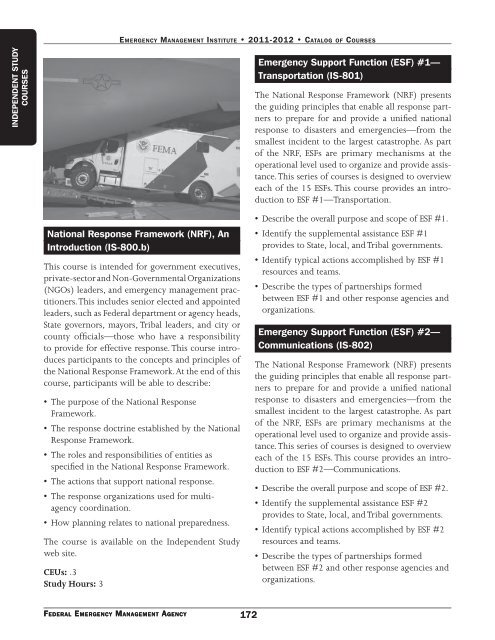EMI Course Catalog - Emergency Management Institute - Federal ...
EMI Course Catalog - Emergency Management Institute - Federal ...
EMI Course Catalog - Emergency Management Institute - Federal ...
Create successful ePaper yourself
Turn your PDF publications into a flip-book with our unique Google optimized e-Paper software.
InDEpEnDEnt stuDy<br />
cOursEs<br />
EmErgEncy managEmEnt InstItutE • 2011-2012 • catalog of coursEs<br />
national response framework (nrf), an<br />
Introduction (Is-800 .b)<br />
This course is intended for government executives,<br />
private-sector and Non-Governmental Organizations<br />
(NGOs) leaders, and emergency management practitioners.<br />
This includes senior elected and appointed<br />
leaders, such as <strong>Federal</strong> department or agency heads,<br />
State governors, mayors, Tribal leaders, and city or<br />
county officials—those who have a responsibility<br />
to provide for effective response. This course introduces<br />
participants to the concepts and principles of<br />
the National Response Framework. At the end of this<br />
course, participants will be able to describe:<br />
• The purpose of the National Response<br />
Framework.<br />
• The response doctrine established by the National<br />
Response Framework.<br />
• The roles and responsibilities of entities as<br />
specified in the National Response Framework.<br />
• The actions that support national response.<br />
• The response organizations used for multiagency<br />
coordination.<br />
• How planning relates to national preparedness.<br />
The course is available on the Independent Study<br />
web site.<br />
CEUs: .3<br />
Study Hours: 3<br />
FEdErAL EmErgENCy mANAgEmENT AgENCy 17 172<br />
<strong>Emergency</strong> support function (Esf) #1—<br />
transportation (Is-801)<br />
The National Response Framework (NRF) presents<br />
the guiding principles that enable all response partners<br />
to prepare for and provide a unified national<br />
response to disasters and emergencies—from the<br />
smallest incident to the largest catastrophe. As part<br />
of the NRF, ESFs are primary mechanisms at the<br />
operational level used to organize and provide assistance.<br />
This series of courses is designed to overview<br />
each of the 15 ESFs. This course provides an introduction<br />
to ESF #1—Transportation.<br />
• Describe the overall purpose and scope of ESF #1.<br />
• Identify the supplemental assistance ESF #1<br />
provides to State, local, and Tribal governments.<br />
• Identify typical actions accomplished by ESF #1<br />
resources and teams.<br />
• Describe the types of partnerships formed<br />
between ESF #1 and other response agencies and<br />
organizations.<br />
<strong>Emergency</strong> support function (Esf) #2—<br />
communications (Is-802)<br />
The National Response Framework (NRF) presents<br />
the guiding principles that enable all response partners<br />
to prepare for and provide a unified national<br />
response to disasters and emergencies—from the<br />
smallest incident to the largest catastrophe. As part<br />
of the NRF, ESFs are primary mechanisms at the<br />
operational level used to organize and provide assistance.<br />
This series of courses is designed to overview<br />
each of the 15 ESFs. This course provides an introduction<br />
to ESF #2—Communications.<br />
• Describe the overall purpose and scope of ESF #2.<br />
• Identify the supplemental assistance ESF #2<br />
provides to State, local, and Tribal governments.<br />
• Identify typical actions accomplished by ESF #2<br />
resources and teams.<br />
• Describe the types of partnerships formed<br />
between ESF #2 and other response agencies and<br />
organizations.

















